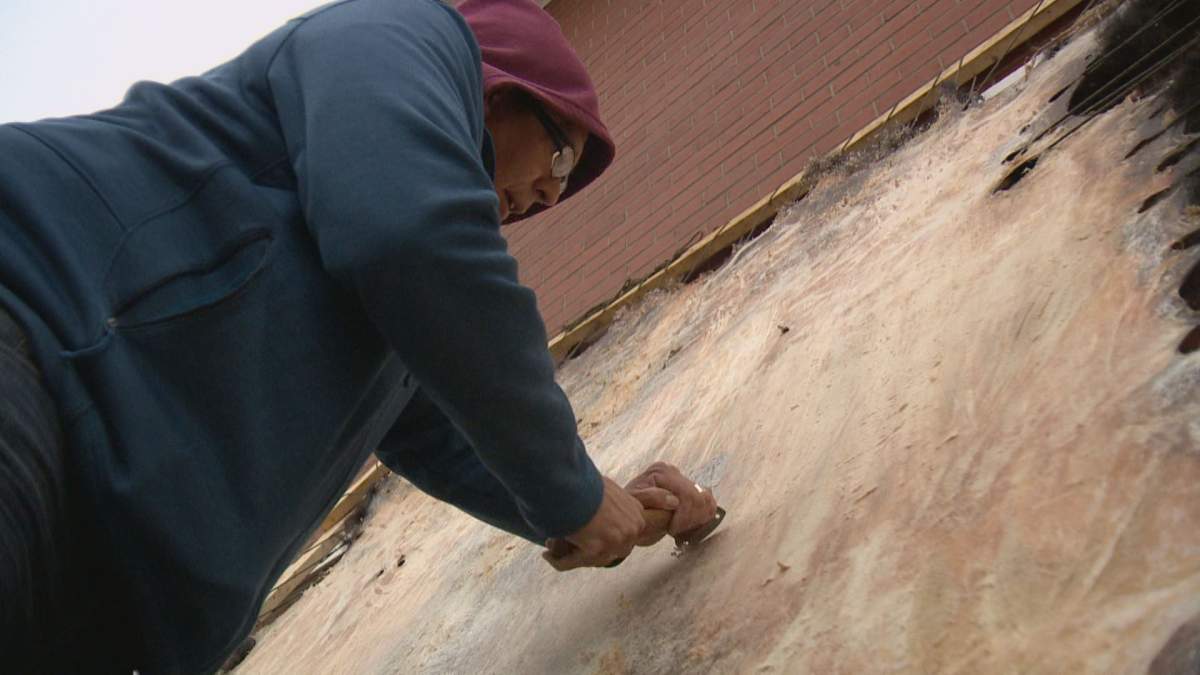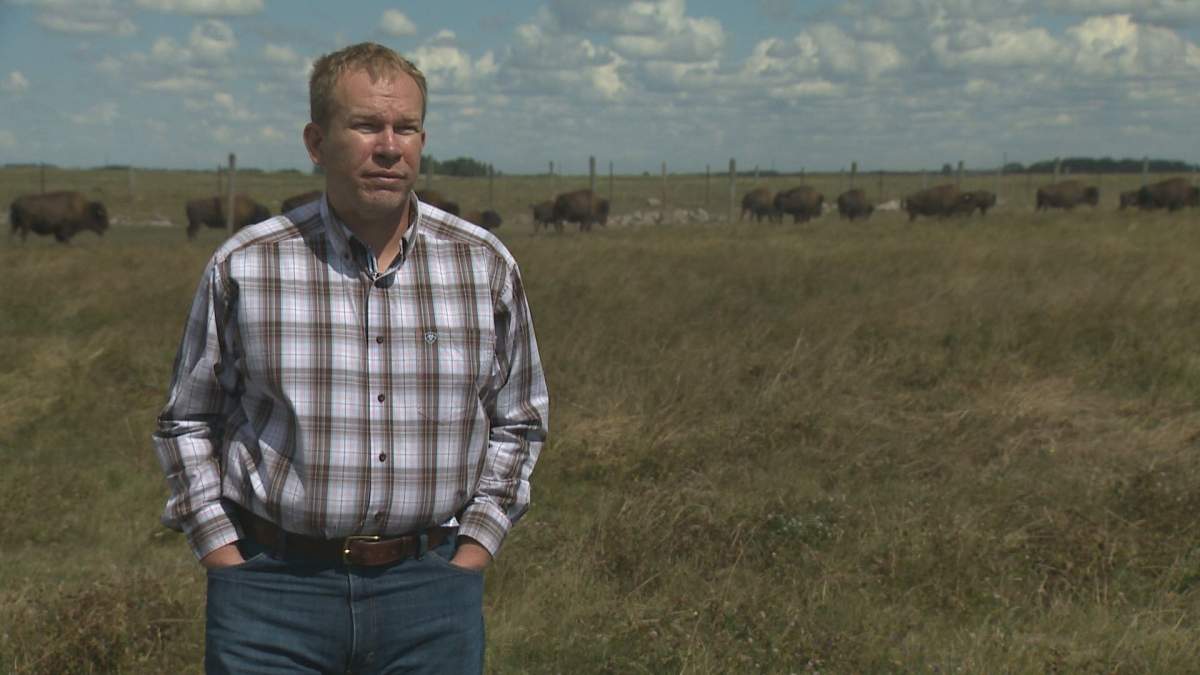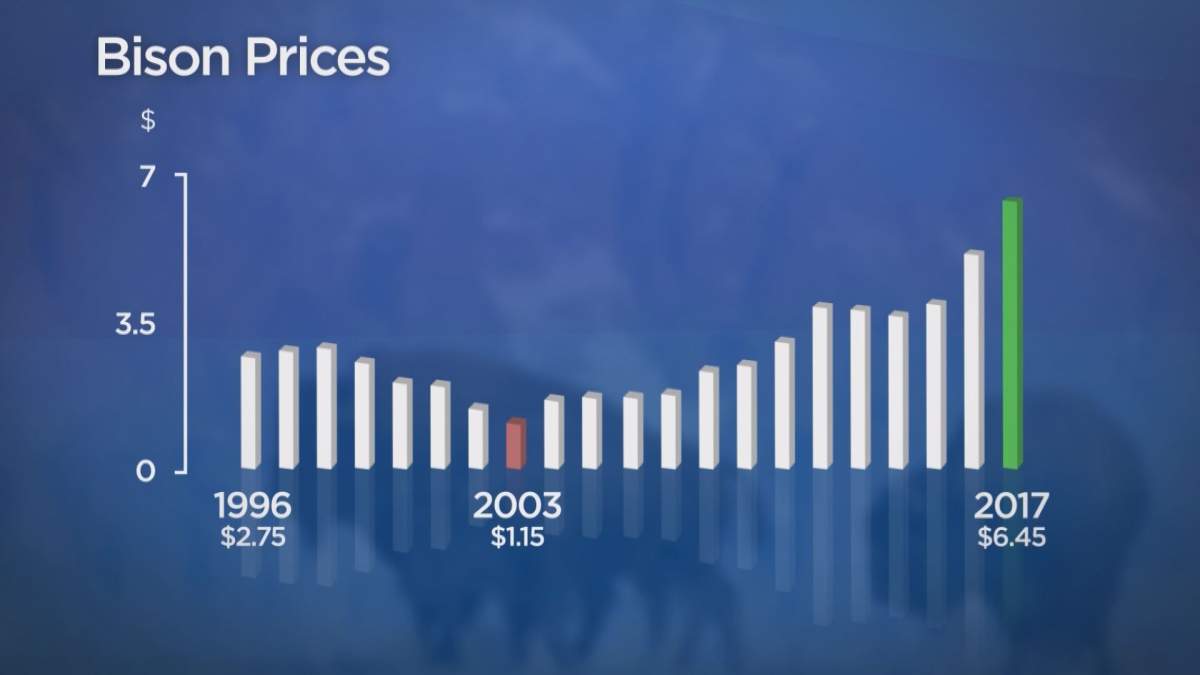Hundreds of years ago, the prairie land of western Canada was dominated by a massive and resourceful animal. Estimations vary, but it is popularly believed that over 30 million bison once roamed North America.

For Indigenous peoples in what is now Saskatchewan, bison — or buffalo — were a source of life. The animal provided not only food, but material for shelter, clothing and ceremonial objects.
Lorne Kequahtooway has learned the traditional way of cleaning and tanning buffalo hide and now teaches the process at school demonstrations with his organization, the Buffalo People Arts Institute.
“The buffalo sacrificed itself for us,” he said.
“The importance of the buffalo to First Nations people who lived here — they were our source of food, clothing, shelter. They were our source of economy.”
However, by the late 19th century, bison numbers in the prairies plummeted from the tens of millions to fewer than 700. As Europeans pushed west across the plains, they hunted bison as fast as they could skin them. The arrival of horses — as well as high-powered rifles — allowed hunters and traders to fill the high demand for leather overseas.
Canadian and American governments also supported the killing off of bison in order to make Indigenous peoples more reliant on cattle provided through the reserve system.
“In order to settle the west, they needed to remove Indigenous people. In order to remove Indigenous people, they tried different kind of ways and one way was to exterminate the buffalo,” Buffalo People Arts Institute co-founder Joely Bigeagle-Kequahtooway said.
How the bison came back
For years, bison numbers stayed in the low hundreds, protected only by some dedicated farmers and conservationists.
In 1907, more than 700 plains bison were purchased from Montana and relocated to Elk Island National Park in Alberta. The bison from the Elk Island herd reproduced and were used to establish new populations on farms in western Canada — namely in Alberta and Saskatchewan.
The Canadian Bison Association started tracking the country’s bison population in 1996. Back then, Canada was home to 45,000 bison — 7,000 of which were in Saskatchewan.

Get daily National news
In the years since, the bison population has boomed to 145,000 with one third of the animals living in Saskatchewan.
Added to the thriving population of bison in the United States, bison numbers in North America amount to roughly 500,000.
“We’re not dealing with less than 1,000 bison. We’re dealing with well over 400,000,” Canadian Bison Association executive director Terry Kremeniuk said.
“It’s a fabulous story.”
A thriving industry
Robert Johnson took over his father-in-law’s bison farm just south of Fairlight, Sask. in 2015. On 2,100 acres of land, he cares for 1,400 bison. For perspective, Johnson’s RJ Game Farm is home to double the number of bison found on the entire continent just 130 years ago.
Johnson comes from a cattle background, and said bison are far more low-maintenance than their bovine counterparts.
“They’re the ultimate native animal,” Johnson said.
“Some people ask about calving them out or different aspects of it and I just kind of grin and smile and say, ‘They haven’t had humanity breeding the smarts out of them for 5,000 years.’”
Because bison evolved on the prairies, they are extremely well-equipped to survive the prairie climate and don’t require any artificial shelter like barns — a money-saving perk for producers.
Bison are also able to reproduce for longer periods of time, usually upwards of 20 years, and often without any assistance from producers.
While the hands-off nature of raising bison is a large element of the so-called ‘bison advantage’, the real attraction for producers is the market. The vast majority of Johnson’s bison exports go to the United States to meet a growing demand for bison meat.
“It’s all part of the clean eating trend,” Johnson said.
“There’s a great demand for the product simply because of its nutritional benefits and it tastes good. When I talk about nutritional benefits, I mean it’s lower in fat, lower in cholesterol, high in iron and it’s very protein dense. For folks who enjoy healthy eating, bison fits the bill very well,” Kremeniuk said.
There is also high demand for bison internationally. While beef producers can be found all over the world, bison are a truly North American export.
“If you’re in Hong Kong and you order a bison rib-eye or a bison burger, chances are it’s a Canadian one and it was raised on a farm just like this,” Johnson said.
Demand for the product has fueled consistently high prices. Bison sold for a record low back in 2003, when the price was $1.15/lb of Grade A hot hanging meat. In the years since, the value has increased about 300 per cent to $6.45/lb in 2017.
“It’s a really good time to be in the bison industry,” Johnson said.
“Today we’re seeing a number of young people getting into the bison industry. Are they coming in by the hundreds? No, but they are entering the industry because of the opportunities the industry provides,” Kremeniuk said.
In July, the Canadian Bison Association and the National Bison Association from the United States made a historic announcement in Big Sky, Montana. The two groups have set a target of one million bison in North America within ten years.
Kremeniuk said it’s an aggressive target, but growth forecasts support the idea that the population could reach the target under optimal conditions and with the cooperation of government, conservation authorities and First Nations.
Off the farm
Bison are also being reintroduced to the wild. In February, Parks Canada released 16 bison in Banff National Park. Just a few months later, three calves were born in the area for the first time in 140 years.
READ MORE: Wild bison back in Banff National Park
Wanuskewin Heritage Park near Saskatoon could be the next place to hold a protected bison herd. The Thundering Ahead campaign aims to raise $40 million for improvements at the site, which includes reintroducing bison to the plains they used to roam.
READ MORE: Wanuskewin Heritage Park $40M renewal plan includes a bison herd
Off the farm, organizations like the Buffalo People Arts Institute share the story of the buffalo and its sacred connection to First Nations people. While Bigeagle-Kequahtooway is excited to see the return of bison as part of an industry, she wants to see more cultural symbols of buffalo in community spaces across Saskatchewan.
“This used to be the land of the buffalo, so where are they?” she said.
“Not just physically but symbolically. Where are the sculptures, where are the paintings, where are the artifacts? Where is the acknowledgement that they were here before us?”











Comments